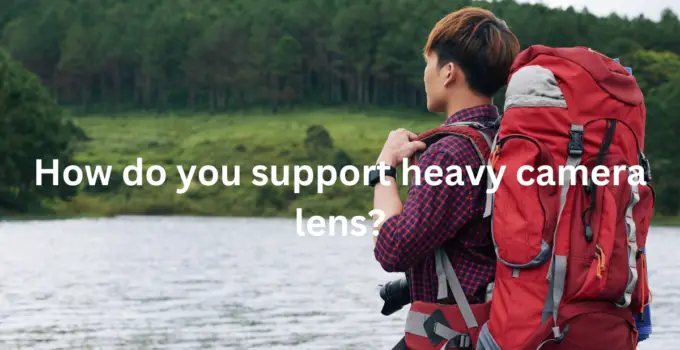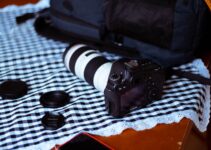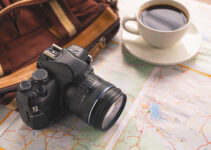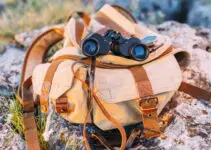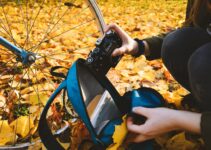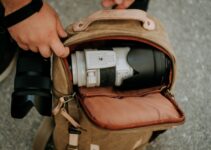As a photographer, traveller, and vlogger, you know that having a good camera lens is important. But what do you do when your camera lens is too heavy for your tripod? Here are four tips to help support your heavy camera lens.
Proven tips to support your heavy camera lenses
Before knowing prone tips take a look at how do you carry your camera around. If you feel like you don’t have enough equipment and don’t know how do you support having a camera lens.
Although Camera lenses come in a wide range of sizes, from small point-and-shoot models to large telephoto lenses.
Supporting a heavy camera lens can be difficult, particularly if you don’t have the right equipment. Here are a few tips to help you get started:
– Use a tripod:
A tripod will take the weight off your arms and help to keep the camera steady. If you don’t have a tripod, look for something else that you can use to prop up the camera, like a stack of books or a chair.
– Use a lens hood:
A lens hood can help to reduce glare and protect the lens from scratches.
– Use both hands:
When possible, use both hands to support the lens. This will help to distribute the weight more evenly and prevent fatigue.
Following these tips should help you to support even the heaviest camera lenses safely.
Although, here are a few more alternatives that help you support your camera lens.
9 alternative that helps you suppose heavy camera lens
Here you can see 9 alternatives that help you support heavy camera lenses.
- Monopods
- Sandbag / Beanbag
- Camera Stands / Extension Poles
- Chest Mounts / Shoulder Rigs
- Window Mounts
- Clamps
- Suction-Cup Mounts
- Tabletop Tripods and Short Supports
- Stabilizers
Let’s discuss them thoroughly.
-
Monopods
A monopod is a single pole that cameras can be attached to in order to provide support and stabilization. They are particularly helpful when shooting with heavy lenses, as they can help to distribute the weight and prevent camera shake.
Monopods are relatively lightweight and easy to carry, making them a convenient option for photographers who are on the go.
While they cannot provide the same level of stability as a tripod, they can be a useful tool for capturing sharp images in challenging environments. Selecting the appropriate model for your camera and lens combination is important when using a monopod.
You will also need to choose the right mounting plate and head and decide whether you need any additional accessories such as a carrying case or tripod adapter.
With so many options available, it can be helpful to consult with a professional photographer or camera store representative before making your purchase.
-
Sandbag / Beanbag
Supporting a heavy camera lens can be done in a couple of ways, the most common being with a sandbag or beanbag.
A sandbag is filled with sand or another type of Granular substance and can be easily wedged under a tripod leg or camera body to provide extra stability.
A beanbag is similar but filled with small beads or pellets instead of sand. They both work great for absorbing vibrations and providing extra stability, but each has its own advantages and disadvantages.
Sandbags are typically cheaper and easier to find but can be messy and difficult to store. Beanbags are more expensive but much lighter and easier to carry around. Ultimately, it’s up to you to decide which option is best for your needs.
-
Camera Stands / Extension Poles
There are a few ways to support a heavy camera lens: a camera stand or an extension pole. Both have their pros and cons.
Camera stands are typically more stable but can be bulky and difficult to transport. On the other hand, extension poles are lighter and more portable, but they can be less stable.
Ultimately, it’s up to you to decide which method is best for your needs. However, both camera stands and extension poles can be great ways to support a heavy camera lens.
-
Chest Mounts / Shoulder Rigs
You have a few options if you’re looking to support a heavy camera lens. One is to use a chest mount, which attaches the lens to your chest and takes the weight off your arms.
Another option is a shoulder rig, which attaches the lens to your shoulder and provides additional support.
Either way, you’ll be able to take clear, steady photos with ease. So if you’re looking for a way to keep your lens supported, consider one of these methods.
-
Window Mounts
If you’re using a heavier camera lens, you’ll need a window mount to support it. There are a few different types of window mounts, but the most important thing is to make sure that the mount is sturdy and won’t shake when you’re trying to take a photo.
A good way to test this is to try mounting the lens on the mount and then gently shaking it. The mount should be able to hold the lens securely without any movement.
Also, make sure that the mount is firmly attached to the window so there’s no risk of it falling loose while you’re using it. With a little bit of care, a window mount can be a great way to support a heavy camera lens.
-
Clamps
When setting up your shots, it is important to make sure that your camera is stable. This is especially true when using a heavy lens, as any movement can result in blurriness.
One way to achieve this stability is to use clamps. You can prevent your camera from shaking or moving by attaching your camera to a solid surface, such as a tripod or light stand.
Additionally, clamps can be used to secure other items, such as reflectors or diffusers.
By taking the time to set up your shot properly, you can ensure that you get the best possible results.
-
Suction-Cup Mounts
When it comes to camera support, suction-cup mounts are often the unsung heroes of the industry. These versatile mounts can support various camera types and lens sizes, making them an essential piece of equipment for any photographer.
While they are often used to support smaller lenses, suction-cup mounts can also support larger, heavier ones. When choosing a suction-cup mount, it is important to select one that is rated for the specific weight of your camera and lens.
Once you have the right mount, simply attach it to a smooth, flat surface, and you’re ready to start shooting.
Thanks to their versatility and durability, suction-cup mounts are essential for any photographer who wants to capture steadier, sharper images.
- Tabletop Tripods and Short Supports
If you’re a photographer, chances are you have at least one heavy camera lens.
And if you’ve ever tried to support that lens on a regular tripod, you know just how unwieldy and top-heavy it can be.
That’s why many photographers invest in tabletop tripods and short supports specifically designed for heavy lenses.
Tabletop tripods are small, lightweight tripods that can be easily set up on any flat surface.
They’re perfect for when you need to make quick adjustments to your camera position or when you’re working in tight spaces. Short supports are similar to regular tripod legs but much shorter and sturdier.
This makes them ideal for supporting heavy lenses, which can put a lot of strain on regular tripod legs.
Investing in a good quality tabletop tripod or short support can make a big difference in your photography. They’ll help you get the most out of your heavy camera lens and allow you to take sharper, clearer photos.
-
Stabilizers
When you’re out shooting, the last thing you want is for your camera to shake and ruin a perfectly good shot. That’s where stabilizers come in.
Stabilizers help keep your camera steady, whether you’re using a handheld camera or a DSLR with a heavy lens.
There are a variety of stabilizers on the market, from simple tighteners that you attach to your tripod to full-fledged gimbals that keep your camera rock-solid even when you’re moving around.
No matter what type of stabilizer you choose, it’s important to make sure that it’s properly attached to your camera before you start shooting. Otherwise, you might find yourself with some blurry pictures.
Related FAQ’s
How to carry cameras with the heavy lenses?
Well, there are a few things you can do to make it easier to carry your camera with a heavy lens. First, try using a camera strap that spreads the weight of the camera and lens evenly across your shoulders.
Second, use a backpack with a padded section that will protect your camera and lens. Third, try carrying your camera in one hand and the lens in the other.
And finally, if all else fails, you can always get a tripod!
How heavy a lens can you attach to your camera body before the lens mount breaks?
It depends on the lens mount.
Some lenses have a smaller amount that is more durable, while others have a larger amount that is less durable. If you are not sure which type of mount your camera has, consult your camera’s manual or contact the manufacturer.
It is generally best to use the smallest lens possible to avoid overloading the lens mount. This will help to prevent damage and ensure a longer life for your camera and lenses.
How do you hold a heavy camera lens?
There is no one-size-fits-all answer to this question, as the best way to hold a heavy camera lens will vary depending on the type of lens and its weight. However, here are a few tips that might help:
If the lens is mounted on a tripod, use the tripod’s mount as your point of stability. If you’re handholding the lens, try to distribute its weight evenly between both hands.
You may also want to use your body’s natural weight distribution to help keep the lens stable.
For example, if you’re holding the lens with your right hand, lean your body slightly towards your left side. And lastly, be sure to use both hands when possible – holding a heavy
How do you stabilize long lenses?
When using a long lens, it’s important to keep the camera as still as possible to avoid image blur. Here are a few tips for stabilizing your camera while shooting with a long lens:
- Use a tripod whenever possible.
- If you’re not using a tripod, brace your elbows against your ribs and hold the camera against your forehead and neck.
- Try to use a shutter speed of 1/500th of a second or faster to help reduce the chances of getting blurry images.
- Keep your head still when pressing the shutter button.
How do I support a telephoto lens?
Supporting a telephoto lens is important to maintain image quality and to avoid camera shake. There are a few ways to support a telephoto lens:
1) Use a tripod or monopod.
2) Place the camera on a stable surface.
3) Hold the camera with both hands, using your left hand as a support underneath the lens.
4) Brace your arms against your body for added stability.
Conclusion:
Supporting a heavy camera lens can be done in a variety of ways. One way is to use a tripod or monopod.
Another option is to use sandbags, which are available in different weights and sizes. You can also use a beanbag as an improvised support system for your camera lens.
If you’re using a heavier lens, it might be necessary to have more than one person help support the weight of the equipment.
Whatever method you choose, make sure that you take the time to practice using it before heading out on your next photography shoot.
Have you tried any of these methods for supporting your camera lens? What worked best for you? Share your tips with us in the comments below!

